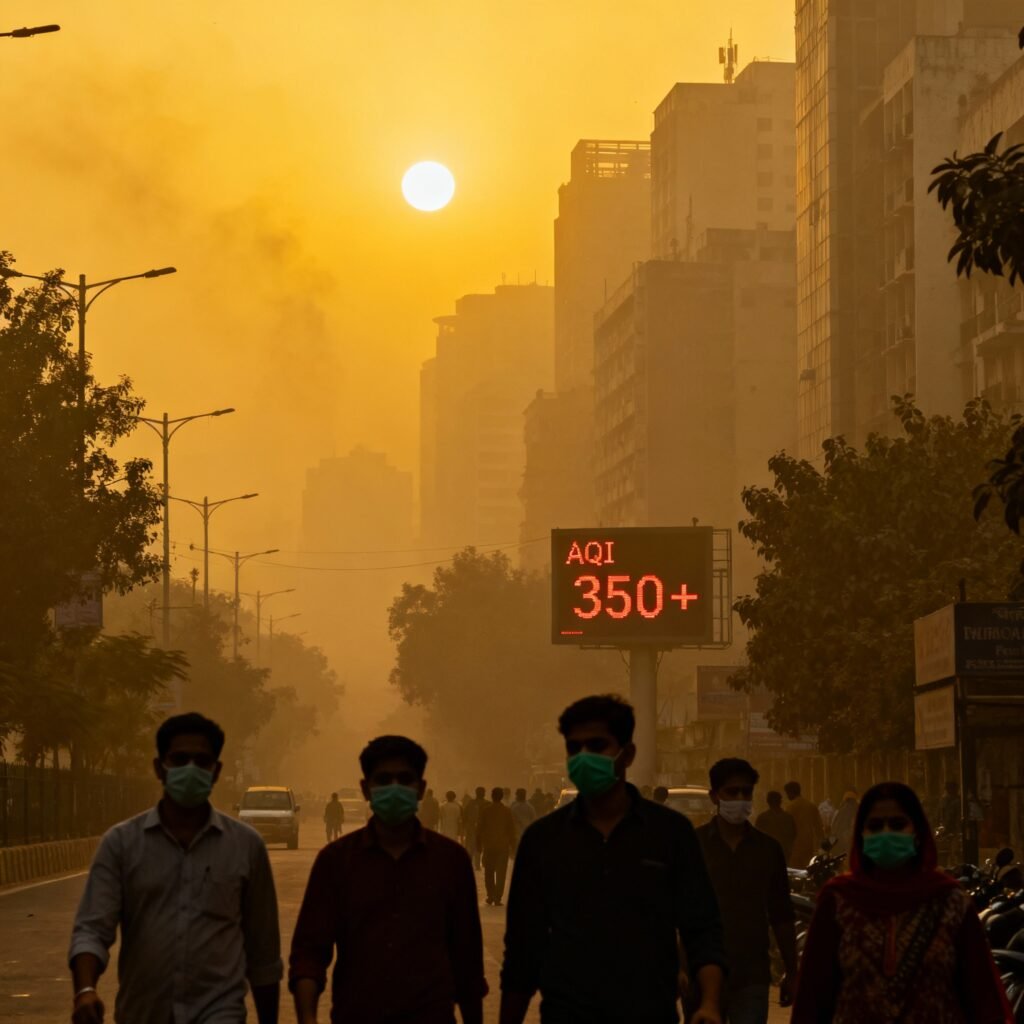Delhi woke up to a hazardous smog blanket after Diwali 2025, with citywide Air Quality Index readings crossing 350350350 at mid-morning and visibility dulled by dense particulate haze across major corridors. Multiple neighborhoods breached the “very poor” to “hazardous” bands as firecracker emissions mixed with stagnant conditions, pushing PM levels to dangerous thresholds for all age groups.
By the numbers
Real-time dashboards showed New Delhi’s composite AQI near 354 late morning on October 22, while PM2.5 hovered around 250 micrograms/cubic meter and PM10 around 324 micrograms/cubic meter, levels associated with high health risk from short exposures alone. Broadcasters reported hotspots such as Ashok Vihar, Bhawana, and Dilshad Garden climbing toward 380, and nearby Gurugram touching 394, underscoring the regional spread of post-festive pollution. Health advisories flagged conditions as “dangerous,” recommending avoiding outdoor activity and limiting exposure even for brief periods due to elevated fine particulate concentrations.
What “very poor” and “hazardous” mean
India’s category definitions place AQI 301–400 as “very poor” and 401–500 as “severe,” ranges associated with increased respiratory symptoms and heightened risk for sensitive and healthy populations alike. With local sensors and city composites breaching the 300+ threshold in many pockets, authorities and clinicians treat the day-after-Diwali window as a public-health incident rather than a routine smog spell. The combination of fine particles less than 2.5 micrometers and co-pollutants like NO2 intensifies inflammatory responses, aggravating asthma, COPD, and cardiovascular stress.
Why it got so bad
Meteorological setup mattered: the early-winter inversion, weak winds, and low mixing heights suppressed vertical dispersion just as emissions spiked from fireworks and overnight burning, trapping pollutants near the surface. Forecast bulletins highlighted ventilation indices falling toward thresholds unfavorable for dispersion—below about 6000 m2/s6000\ m^2/s6000 m2/s with sub‑101010 km/h winds—which amplify pollution accumulation even when emissions are transient. With carryover from stubble burning upwind and urban transport emissions, the firecracker plume became the tipping point for citywide AQI escalation.
The morning after
Dawn broke with a thick, grayish veil over arterial roads and monuments, and commuters reported cough, eye irritation, and throat scratchiness within minutes of exposure in multiple districts. Satellite-style visual maps depicted a uniformly bad NCR basin, with only marginal relief at the extreme periphery, indicating limited advection or cleansing winds. Street-level feeds showed India Gate and central vistas lost in haze, a familiar yet sobering post-Diwali tableau for the capital.
Immediate health guidance
Stay indoors as much as possible, especially for children, the elderly, pregnant people, and anyone with heart or lung conditions, as conditions are labeled “dangerous” by air-quality health indices today. If going out is unavoidable, wear a well-fitted N95/FFP2 mask and avoid exertion; postpone outdoor workouts and keep inhalers, eye lubricants, and rescue meds accessible if you are a respiratory patient. Run certified HEPA air purifiers on high in a closed room, and consider creating a clean-air microspace to reduce acute exposure during peak hours.
What authorities have activated
Regional briefings referenced escalated controls similar to GRAP Stage 2—curbs on certain construction activities, targeted water sprinkling, and bans on open burning—to dampen re-suspension and add-on sources during the worst hours. Forecast centers indicated a likely evolution from “severe” on October 21 to “very poor” October 22–24, contingent on modest improvements in mixing and wind, though still unhealthy for sensitive groups. Residents should track civic advisories through the day, as incremental measures may be tightened if dispersion conditions underperform.
Planning your day
Schedule essential trips to the briefest windows, favoring mid-afternoon when mixing can be marginally better, though today’s health guidance still advises minimizing exposure altogether. Prefer metro or closed‑cabin transport over two-wheelers or walking to reduce direct inhalation in high-traffic corridors where PM spikes are common. Keep indoor humidity moderate and seal leaky windows facing major roads; even small gaps can increase indoor PM2.5 during peak hours.
Looking ahead this week
Dispersion may improve slightly as mixing depth trends suggest 300030003000 m on October 22 before dipping again into the weekend, which could slow pollutant clearance without a strong wind shift or rain. Forecast bulletins point to “very poor” conditions persisting for several days, making consistent personal exposure reduction more important than one-off precautions today. Continued stubble burning upwind and routine urban emissions could maintain a high baseline even after the firecracker plume settles, warranting vigilance through the week.
How to help reduce the load
Avoid private vehicle use where possible and skip generator runs during peak hours; marginal reductions matter when ventilation is weak and accumulation dominates. Report open waste burning and construction dust violations through local channels as enforcement intensifies under escalated response stages. Community adherence to advisories—paired with pragmatic personal safeguards—can shave the peak and shorten the worst phase of Delhi’s annual post-Diwali pollution spike. Delhi’s toxic haze after Diwali 2025 is a stark reminder that acute emissions plus unfavorable weather can push AQI into hazardous territory within hours, demanding both civic coordination and individual protection to navigate the smog safely. Until cleaner conditions return, treat today like a high‑risk air event: limit exposure, mask up if you must step out, and keep indoor air as clean as possible.


